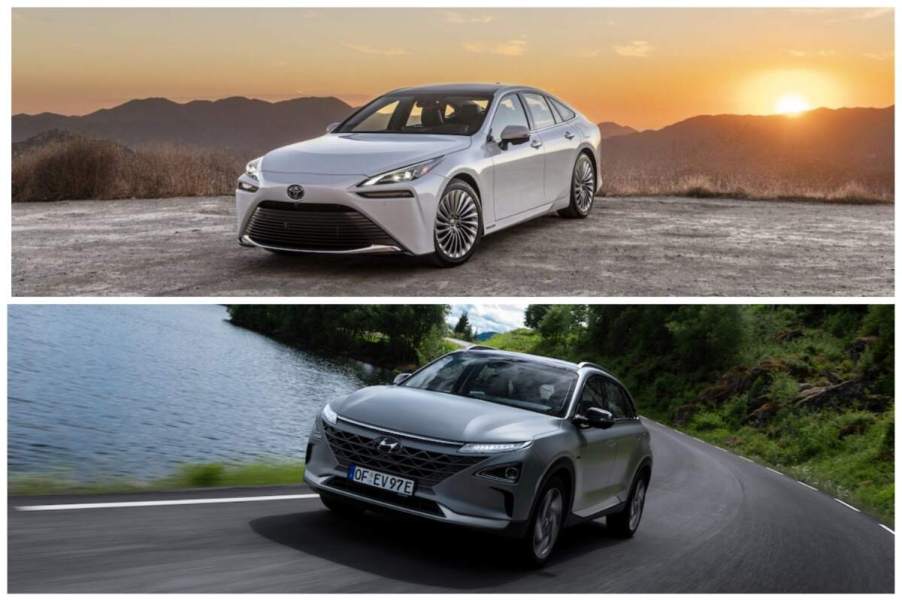
2023 Toyota Mirai vs. 2023 Hyundai Nexo: Heated Hydrogen Rivalry
Hydrogen-powered cars are rare, with the fueling infrastructure relegating them to California. Though unpopular, hydrogen fuel cell cars promise to challenge EVs. Some consumers want to know how the available hydrogen fuel cell models compare. Here’s a side-by-side comparison of the 2023 Toyota Mirai and Hyundai Nexo.
Toyota Mirai vs. Hyundai Nexo: Power and performance comparison

The 2023 Toyota Mirai has a hydrogen fuel cell engine with an electric motor connected to the rear wheel. Toyota says the Mirai produces 182 hp and 221 lb-ft of torque and accelerates from 0 to 60 mph in 9.2 seconds. Though its acceleration isn’t as smooth as EVs like the Tesla Model 3 and Volkswagen ID.3, the Mirai’s continuously variable transmission (CVT) provides an enjoyable driving experience.
The Hyundai Nexo also has an electric fuel cell engine. Unlike the Mirai, the Nexo’s motor is connected to the front wheel and delivers 161 hp and 291 lb-ft of torque. Another difference is in the transmission. The Nexo’s one-speed direct drive transmission drives the vehicle wheel directly. Without a gear to shift, this transmission system provides a smooth and quiet driving experience.
The Mirai vs. Nexo: Which has better fuel economy and driving range?
The Toyota Mirai has a hydrogen tank capacity of 37.5 gallons. However, the vehicle’s smaller size makes it fuel-efficient, getting an EPA-estimated 76 MPGe in the city and 71 MPGe on the highway. Toyota says the average driving range is 402 miles on a full tank. Refilling the Mirai’s empty tank takes approximately five minutes.
On the other hand, Hyundai says the 2023 Nexo has a hydrogen tank capacity of 41.4 gallons, nearly four gallons more than the Mirai’s. The Nexo gets an estimated 65 MPGe in the city and 58 MPGe on the highway. Although the Nexo has a larger tank than the Mirai, the Hyundai model’s weight lowers its range to 380 miles.
Which vehicle is more spacious?
Headroom, legroom, and cargo space are important to most drivers. Of the two hydrogen fuel cars, the Hyundai Nexo prevails in spaciousness. Measuring 183.9 inches long, this crossover SUV boasts luxurious seating for five, an interior volume of 130.9 cubic feet, and a cargo capacity of 29.6 cubic feet behind the rear row. The vehicle’s maximum cargo capacity is 56.6 cubic feet with the back row folded flat.
Though the 2023 Toyota Mirai is quite long — 195.8 inches — this midsize sedan offers less cargo space than its rival. The Mirai also provides refined seating for five but a small cargo hold of only 9.6 cubic feet.
What about pricing and warranty?
Hyundai is known for its generous warranties. According to Hyundai, the Nexo has a five-year/60,000-mile limited warranty, a 10-year/100,000-mile powertrain warranty, and a 10-year/100,000-mile hybrid/EV battery warranty. The starting MSRP for this model is $60,135.
In comparison, the Toyota Mirai has a three-year/36,000-mile basic warranty, a five-year/60,000-mile drivetrain warranty, and an eight-year/100,000-mile fuel cell electric vehicle warranty. Its starting price is $49,500 — over $10,000 less than the Nexo.
The 2023 Toyota Mirai and the 2023 Hyundai Nexo are geared toward different consumers. The Mirai is a sedan, while the Nexo is an SUV. As expected, the Nexo has more interior space, which might appeal more to families. On the other hand, the Mirai is more fuel-efficient and has a lower purchase price.


